America staring down barrel of biggest measles outbreak in decades
- Vaccination rates for measles among children at at record lows, CDC says
- At least 15 cases have been reported since the start of 2024 plus 41 last year
- READ MORE: Four states now reporting measles cases as Philly offers free shots
<!–
<!–
<!– <!–
<!–
(function (src, d, tag){
var s = d.createElement(tag), prev = d.getElementsByTagName(tag)[0];
s.src = src;
prev.parentNode.insertBefore(s, prev);
}(“https://www.dailymail.co.uk/static/gunther/1.17.0/async_bundle–.js”, document, “script”));
<!–
DM.loadCSS(“https://www.dailymail.co.uk/static/gunther/gunther-2159/video_bundle–.css”);
<!–
Measles – a disease that until recently was thought to be consigned to history – is making a resurgence across the US that has doctors worried.
Georgia confirmed its first infected patient in nearly four years this week, making it the fifth state to declare cases of the ultra-contagious virus so far this year.
Delaware, Washington State, New Jersey and Pennsylvania have also reported cases, and doctors fear that this is just the tip of the iceberg, with more measles cases expected to crop up throughout 2024.
There have been a total of at least 15 cases reported this year alone, while 41 were confirmed last year, and there are indications that vaccination rates among children, the population at highest risk of illness, have reached new lows
Nationwide, nearly 4 percent of children entering kindergarten were unvaccinated against MMR, the lowest rate since the 2013-14 school year, raising the odds of seeing a tidal wave of infections.
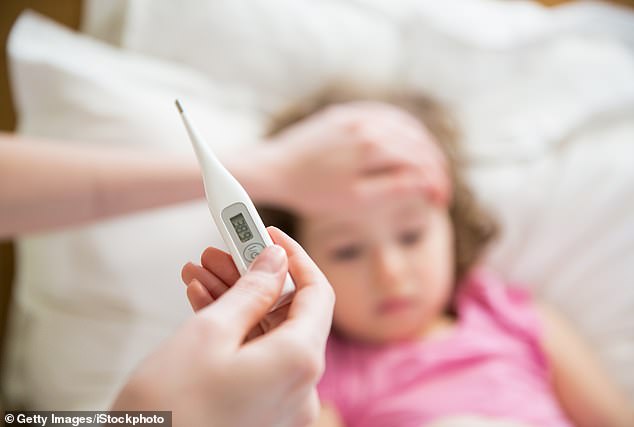
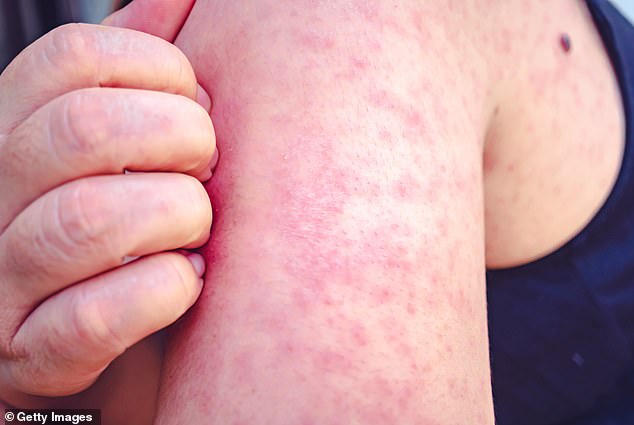
The US is on the brink of a life-threatening situation, with dangerously high rates of unvaccinated individuals, raising the risk of a wave of preventable deaths.
While last year’s figures are lower than those in recent years, the fact that there are still regular outbreaks in America is worrisome for health officials and experts like Food and Drug Administration Commissioner Dr Robert Califf and FDA vaccine regulator Dr Peter Marks, saying: ‘Thousands of excess deaths are likely to occur this season due to illnesses amenable to prevention.’
Measles was declared eliminated in 2000 thanks to the highly effective MMR vaccine for measles as well as mumps and rubella.
But declining rates of childhood vaccinations in recent years alongside the rise of the anti-vax movement has meant cases keep cropping up.
Dr Peter Hotez, the preeminent vaccine expert and a professor of molecular virology at Baylor College of Medicine, said: ‘The fact that we’re seeing sporadic measles cases, to me, says that we probably have pockets in the United States where we’re not doing a good job vaccinating.
He added: ‘I’m worried that this is a trend that’s been getting worse over the years.’
In the UK, health officials fear the world is in for it’s worst outbreak yet, saying the current outbreak affecting multiple countries is on ‘trajectory for everything getting much worse.’
This year, most cases of measles in the US were sparked by a traveler entering the US from a country where measles is more prevalent. But because the virus is so contagious, the patients zero put dozens of people in hospitals and daycares.
An outbreak in Philadelphia that started in a daycare earlier this year – with eight cases have since been confirmed – appears to have spread to neighboring Delaware.
An unvaccinated patient with the disease traveled there to Nemours Children’s Hospital in Wilmington while asymptomatic but infectious on December 29, exposing 20 to 30 people to the disease.
Last weekend, Virginia and New Jersey warned residents over the virus — with New Jersey confirming a case in a child who attended daycare.
Authorities do not know where the child in New Jersey was exposed, and there is no known connection to the Philadelphia outbreak.
Virginia is also warning about potential exposure after being notified of confirmed cases of measles in travelers who had gone to Dulles International Airport on Jan. 3 and Ronald Reagan National Airport on Jan. 4, potentially exposing thousands.
And in Georgia on Thursday, the state’s public health department announced that a resident from the Atlanta region, who had not been vaccinated, traveled abroad and came into contact with the highly contagious virus.
It’s not believed to be connected to the other states’ outbreaks.
According to the department: ‘DPH is working to identify anyone who may have had contact with the individual while they were infectious.’
While there was community spread within Philadelphia, there’s no indication yet that the infections there influenced the new cases in Georgia.
Measles cases skyrocketed in 2019 with 1,274 total cases. The previous record, since 2010, was set in 2014 with 667 cases.
From 2001 to 2009, there were a total of 574 cases. 2008 saw the most cases – 140, followed by 2001 with 116 cases.
Measles is caused by a virus that spreads through respiratory droplets produced when an infected person talks, coughs, or sneezes. Measles virus can stay in the air or on surfaces for up to two hours after an infected person has left the room.
Symptoms typically appear between seven to 14 days after contact with the virus. It can cause a high fever that can be life-threatening, a red rash, cough, fatigue and watery eyes.
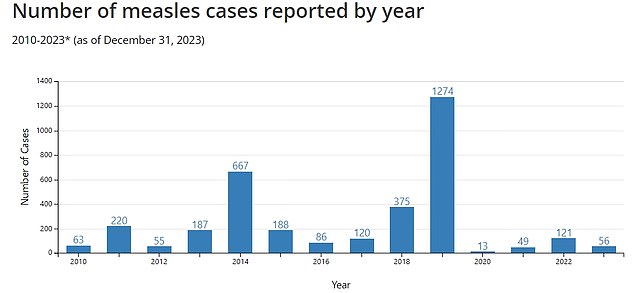
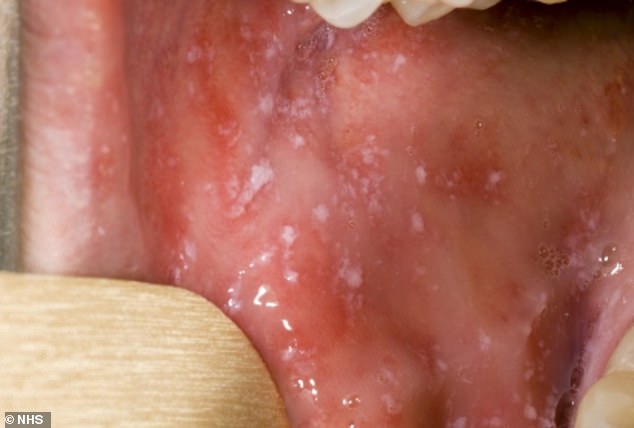
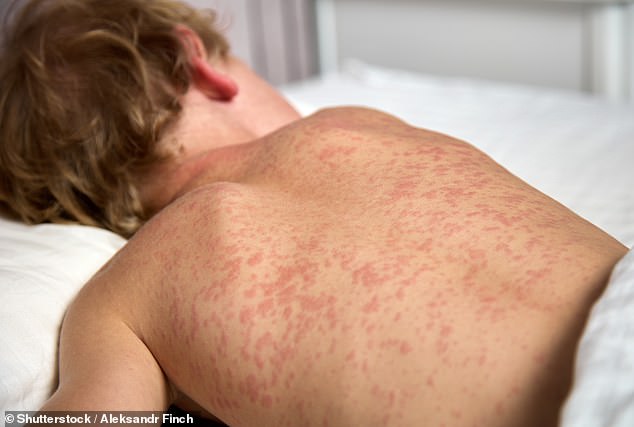
The rash usually starts on the face and behind the ears before spreading to the rest of the body, with the spots of the rash sometimes raised and join together to form blotchy patches. They’re not usually itchy.
On white skin, the rash looks brown, but it may be harder to see on brown and black skin.
In some cases, the infection can also cause sensitivity to light, pneumonia, and brain swelling.
One in five children who become infected end up in the hospital, with one in 15 developing serious complications like meningitis or sepsis. For every 1,000 children who get measles, one or two will die from it.
Approximately 5 percent of children with measles may develop pneumonia, which is the most frequent cause of death in young children with measles.
Additionally, around one in a thousand children who contract measles may experience brain swelling, or encephalitis, characterized by brain swelling, leading to convulsions and potential consequences such as deafness or intellectual disability.
Rates of childhood inoculations dipped most acutely during the first year of the pandemic when visits to the doctor were reserved for the direst circumstances and many well-visits and check-ups fell by the wayside.
But instead of bouncing back once schools reopened in 2021, school-age immunizations remained lower than usual.
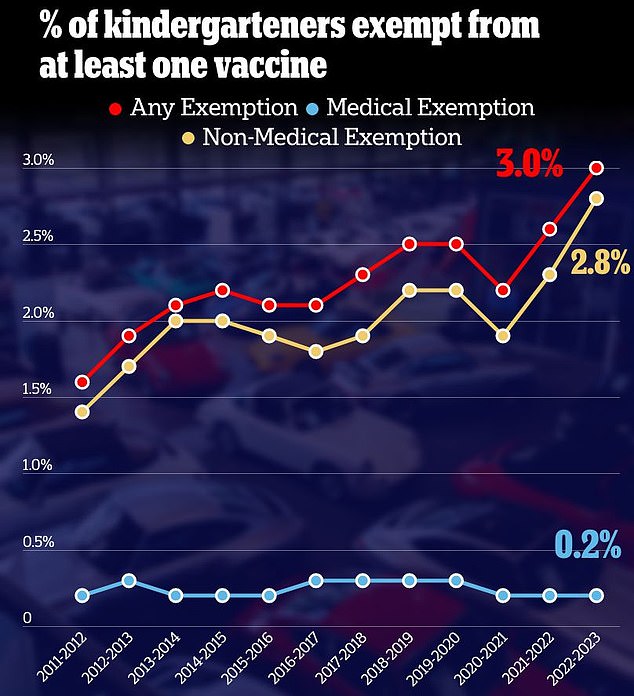
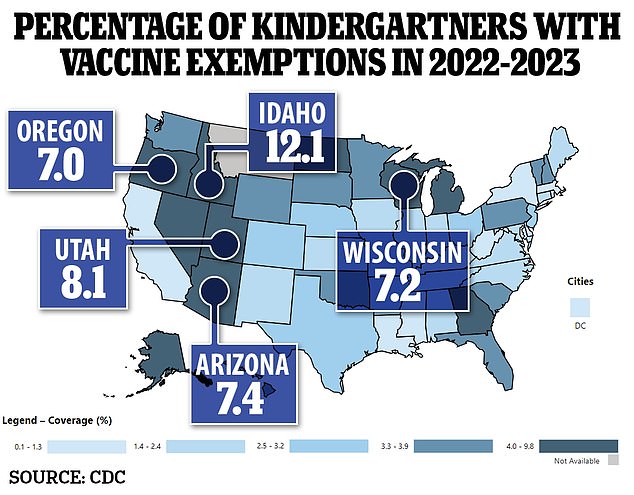
The percentage of American children entering kindergarten with their required immunizations was about 93 percent in the 2022-23 school year, about the same as the previous school year’s, though it was also a whole two percentage points below the recommended levels for herd immunity and lower than vaccination rates in 2020-21.
Herd immunity is a saving grace for children who cannot get vaccinated for medical reasons.
This is when a sufficiently high percentage of a population is immune to a contagious disease, either through vaccination or previous infection. But with declining herd immunity, those children at at high risk.
Philadelphia Health Commissioner Dr Cheryl Bettigole said: ‘Children under 12 months and adults who are immunocompromised remain vulnerable to measles but are generally protected because of the wall of immunity created by high community vaccination levels.
In many states, special exemptions can be made for students to forego vaccines for medical or religious reasons.
The rate of children and their parents requesting exemptions is skyrocketing to record levels, according to the Centers for Disease Control and Prevention, increasing to an average three percent in the 2022-2023 school year, with 10 states now reporting exemptions exceeding five percent.
The UK is also seeing a troubling uptick in cases alongside low vaccination rates.
Fears of an impending measles resurgence today sparked a national ‘call to action’ by health chiefs who are alarmed over vaccination rates slumping to a 10-year low.
As few as half of children have had both measles, mumps and rubella (MMR) jabs in parts of London.
Similarly low levels are also seen in Liverpool, Manchester and Birmingham.
Dame Jenny Harries, chief executive of the UK Health Security Agency, begged parents to check their child’s immunisation status, warning that the public had ‘forgotten what measles is like’ and that it was still a ‘serious illness’.
‘Concerted action’ is needed because the UK is currently on a ‘trajectory for everything getting much worse’, she said.
She also pleaded with the ‘Wakefield generation’ — adults born in the late 1990s or early 2000s — to check their own medical records.
Andrew Wakefield, who wrote a now-debunked 1998 paper in The Lancet tying the MMR vaccines to autism, helped sparked the anti-vax movement.
Subsequent investigations found ethical and methodological flaws in the study. The Lancet retracted the article in 2010, stating that the claims made were false and that Wakefield had acted with a conflict of interest.
Overwhelming scientific consensus is that there are no ties between the MMR vaccine and autism.
This article has been archived for your research. The original version from Daily Mail can be found here.



